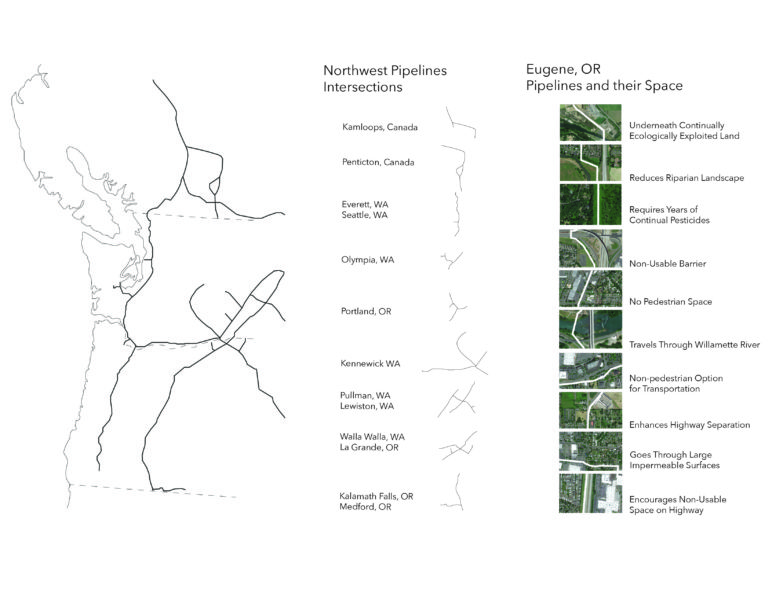The Northwest’s fight against an onslaught of coal, oil, and gas export projects—what Sightline calls the thin green line—has given rise to what is surely one of the most robust environmental movements in the region’s history. Cascadians have stood up in opposition to carbon fuel proposals in numbers unprecedented for any civic debate, repeatedly packing local hearing rooms to standing-room-only, burying government agencies with hundreds of thousands of comment letters, and committing scores of acts of civil disobedience. Not surprisingly, the movement has also begun to generate its own art and architectural studies.
At the University of Oregon, Associate Professor Erin Moore’s architectural design studio “Lines, Pipelines, and the Contested Space of Fossil Fuel Transport in the Pacific Northwest,” in the winter term of 2016, reimagined fossil fuel export schemes. How else might the region develop? What follows are the submissions of three graduate students in the Department of Architecture who were students in the course, along with a description, in their own words, of what they imagined.
Stephanie Morales: “There should be a park, not a pipeline.”
As a response to the studio prompt encouraging us to analyze the space of fossil fuel transportation in the Pacific Northwest, I chose to examine natural gas pipelines both regionally and locally in Eugene, Oregon. My analysis highlights the idea that natural gas pipelines, as they run through Eugene, correspond to unusable space by reducing the riparian landscape, requiring years of continual use of pesticides, or encouraging non-pedestrian options for transportation, among many other devastating realities. As a reaction, I propose a future where non-renewable energy resources are phased out and replaced with cleaner and more renewable options. My design proposal is a park that would create solar energy on-site and would utilize the existing infrastructure, or the space of a once functioning pipeline, to instead create usable space for people. There should be a park, not a pipeline.



Jordan Frazin: “Reconnect to geographic and cultural landscapes”
This design proposal is an exploration of the spatial nature of natural gas infrastructure and investigates the potential of this type of space in a post-carbon world, where natural gas is no longer a feasible energy source. Deriving influence from the pattern of compressor stations and pipelines traversing the landscape, and through viewing the existing routes within the context of cultural history, I propose that new networks take the place of natural gas routes. After choosing a specific pipeline and site to investigate, I developed a concept that is meant to reconnect people to their surrounding geographic and cultural landscapes; the pipeline route becomes a pathway for human travel, and compressor station language is mimicked through the addition of modestly sized, off-grid landscape and cultural history archives with adjacent travelers’ shelters. This architectural program is to be repeated throughout the route in place of the compressor stations.
Susanna Davy: “The global effects of coal use”
3 Moves is a series of land art interventions addressing the connection between the physical lines of coal export, the state-change of coal from biotic material to fuel, and ultimately, to CO2 gas, and the global effects of coal usage. Ill Wind, the third installment of the project, is a jetty placed along the Columbia River, outside of the proposed coal export facility at Boardman, Oregon. It manifests the global effects of coal use by demonstrating the connection between the air we breathe in the Pacific Northwest and air polluted by coal burning in China. On the jetty, a swarm of black panels acts as weathervanes, aligning into a dark smudge along the river, as winds from China are funneled up the Columbia River Gorge. A screen at the terminus of the jetty projects air quality images taken in Beijing on the day the air would have begun its journey to the United States, based on wind speed and direction.
Like what you're reading? Find out more about the Thin Green Line here.















Comments